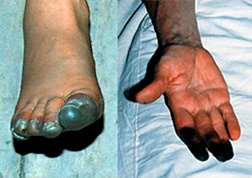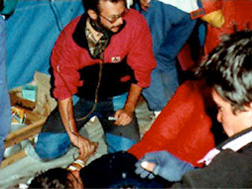Mountain Illnesses
Aconcagua
Acute Mountain Sickness (AMS)
A common problem that may be very dangerous is due to bad adaptation to the altitude which is called altitude sickness. The symptoms of this problem appear beyond 2500-3000 meters. They mainly affect people who are not used to these altitudes. The appearance of AMS is based on two principles: on the climbing speed and on the method. The signs of bad adaptation appear 4 to 8 hours after having reached a high altitude and remained there.
Good climbers usually hide the signs of bad adaptation, but accepting this should not be considered a failure. Many times it is typical to suffer from altitude sickness at these altitudes and climbers must be responsible enough to stop and reconsider a descent. Even great climbers have suffered from this problem.
To facilitate its detection, practical table has been developed, assigning values to the different symptoms in order to determine the seriousness of the sickness.
1 Point
• Slight headache
• Nausea or loss of appetite
• Insomnia
• Vertigo
2 points
• aspirin-resistant headache
• Vomiting
3 points
• Dyspnea at rest (lack of air)
• Abnormal fatigue
• Lack of urine.
| Rating | Definition | Treatment |
| 1 a 3 | MAM mild | Aspirin or paracetamo |
| 4 a 6 | MAM moderate | Aspirin, rest, stop ascent |
| over 6 | MAM acute | Descend |
All these symptoms disappear with the descent. In case of doubt or if the symptoms persist, even though mild, it is advisable to descend to climb up again more slowly in order to facilitate acclimation.
The AMS should not be ignored or hidden. At first, the symptoms may be attributed to discomfort, change in eating habits or fatigue and are usually hidden lest they would be interpreted as a sign of weakness.
This problem can affect any climber, whatever his physical condition, size, training or experience, and if not treated timely it may derive in pulmonary or cerebral edema, even leading to death.
If possible consult a physician or somebody who could provide medical care.
Freezing

Rescue team – Climbing Aconcagua Argentina
The beginning of freezing presents very special symptoms. First, in the exposed parts of the body, the cold makes us feel pain when we hit them; then all feeling disappears and the frozen part becomes anesthetized. The skin begins to change its natural color and becomes reddish or whitish, blisters appear and the area starts to gradually turn black.
The parts of the body that suffer most from freezing are the hands, fingers, feet and some parts of the face. Therefore, it is advisable to have and wear adequate climbing gear for low temperatures. Good (dry) socks must always be worn as well as adequate double boots, an excellent quality and fabric windbreaker, a balaclava, and finally, gloves and high quality mittens if possible.
In the event of the onset of freezing, the affected area must be put in contact with warm parts of the body. In case of more serious situations, warming up must not be attempted until the person is in an adequate place; otherwise, the situation may become even worse. Warming up an area of a person’s body is a slow task that must be done by introducing the affected part in warm water (37° C or 98.6º F) and heating it progressively up to 40° C (104º F).
After the warm-up process, the affected person will feel pain in his body and infections may appear. It is advisable to send the person to hospital. If possible consult a physician or somebody who could provide medical care.
In the event of the onset of freezing, the affected area must be put in contact with warm parts of the body. In case of more serious situations, warming up must not be attempted until the person is in an adequate place; otherwise, the situation may become even worse. Warming up an area of a person’s body is a slow task that must be done by introducing the affected part in warm water (37° C or 98.6º F) and heating it progressively up to 40° C (104º F).
After the warm-up process, the affected person will feel pain in his body and infections may appear. It is advisable to send the person to hospital. If possible consult a physician or somebody who could provide medical care.
Edemas
Pulmonary Edema

Aconcagua Mendoza – Mountain illnesses
The signs of this disease are shortness of breath and noisy breathing (gurgling). The lips, and often the ears, turn purple or blue (cyanosis); there may be foamy expectoration, sometimes pink. These symptoms may appear at night, after a long day’s effort. It is advisable to keep the sick person seated while looking for help.
Cerebral Edema
It is characterized by fatigue or extreme weakness, vomiting (often violent) and an acute and persistent headache. There is a difficulty to remain standing as well as vertigo and behavior disorders. The comma comes quickly. Sometimes there is no headache, but just extreme fatigue and equilibrium disorders.
Both cases of edema must be treated urgently and the person needs to be rescued as soon as possible. Edema is treated as an emergency introducing the person in a hyperbaric chamber to try to revert the symptoms and keep the person alive until he can be transferred to a hospital for more specific care. When the first symptoms appear, or in case of suspicion, consult the medical service at the park or report to the park ranger.
Body Reactions
Staying for long at high altitudes may bring about digestion disorders (anorexia and dyspepsia) and metabolic disorders (negative calorie and protein balance). Therefore, it is common to lose weight (about 0,5 to 2 kilograms per week), at the beginning due to lipolysis, and after the first ten days due to the loss of muscular mass. It takes about three months after the ascent for the body to recover from that weight loss. Other potentially dangerous complications are retina hemorrhages due to the altitude, vascular thrombosis and altitude psychosis, very serious in an aggressive environment where mistakes may be paid with life.
If possible consult a physician or somebody who could provide medical care.